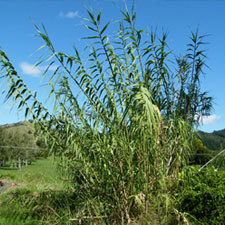 Giant reed
Giant reed
Common name: Giant reed
Botanical name: Arundo donax
Management category: Advisory
Originally from Europe and North Africa. It was introduced to New Zealand as an ornamental species and was recorded as naturalised in 1936.
Why is it a pest?
- Slowly crowds out all other species, often killing plants by smothering them from above.
- Forms dense thickets, can block streams, drainage and cause flooding.
Where is it found?
- Streamsides, estuaries (to waterline), disturbed lowland and coastal forest margins, river systems, and gullies.
- Found scattered and in isolated clumps throughout the Bay of Plenty.
What does it look like?
- Massive clump-forming perennial with thin green or variegated leaves that tend to droop at the edges of clumps where it is not supported by the mass of canes.
- It has dense root mass and short rhizomes.
- Woody stems are erect but become semi-lax over time.
- Bluish white (occasionally striped) bamboo-like leaves with parallel veins are arranged alternately along the stems.
- Fluffy terminal seedhead.
What are the rules?
Advisory
Council does not enforce the control of advisory species. It is landowner/ occupier responsibility to manage these pests. Council may provide advice on how to manage or control advisory species if required.
How do you get rid of it?
- Dig-out (all year) – entire root mass, dispose by incineration or transfer station.
- Spray year round – Need to cut close to ground prior to spraying.
CAUTION: When using any herbicide or pesticide, PLEASE READ THE LABEL THOROUGHLY to ensure that all instructions and directions for the purchase, use and storage of the product, are followed and adhered to.
Read more on pest control advice, information and regulations.
Images




